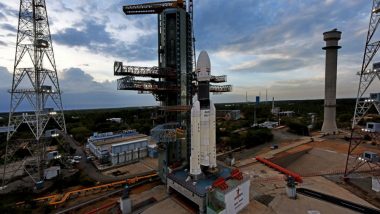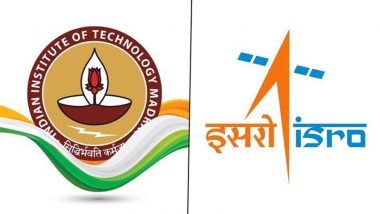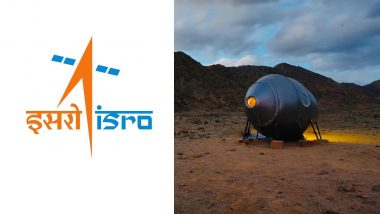Chandrayaan-2 mission, India's second ambitious mission to the moon, is set to be launched at 2: 43 pm on Monday from Sriharikota in Andhra Pradesh. The countdown for the Rs 978-crore lunar mission began at 6: 43 pm on July 21, progressed smoothly, the Indian Space Research Organisation (ISRO) said. During the countdown, the rocket and spacecraft's systems will undergo checks and fueling. The rocket, which will be launched today, will deliver Chandrayaan-2 in Earth's orbit. This spacecraft consists of three modules — Orbiter, Lander and Rover. Catch Chandrayaan 2 Launch by ISRO Live News Updates Here.
The rocket, nicknamed as 'Baahubali', will carry the 3.8-tonne Chandrayaan 2 spacecraft which has three modules namely Orbiter, Lander (Vikram) and Rover (Pragyan). The lander is named 'Vikram' as a tribute to the pioneer of India's space programme and former ISRO chairman Vikram Sarabhai. Chandrayaan 2 Launched Successfully by ISRO From Satish Dhawan Space Centre in Sriharikota; India Scripts History With Second Moon Mission.
About 16-minutes into its flight on Monday, the GSLV-Mk III rocket is expected to sling the Rs 603 crore Chandrayaan-2 into an Earth parking 170x40400 km orbit. The GSLV-Mk III rocket is nicknamed the 'Baahubali', an allusion to the eponymous character from the film Baahubali, who lifted a heavy lingam.
When Will Chandrayaan 2 Reach Moon?
The lunar landing is expected to happen around September 7, 2019, as per details available on the ISRO website. Scientific experiments will continue on the lunar surface for 14 Earth day (1 lunar day) while the orbital experiment will happen for about 1 year. The Chandrayaan - 2 will be launched on July 22, 2019, at 14:43 hrs IST (2.43 pm) from Satish Dhawan Space Center at Sriharikota onboard GSLV Mk-III. It will be injected into an earth parking 170 x 39120 km orbit. A series of manoeuvres will be carried out to raise its orbit and put Chandrayaan-2 on Lunar Transfer Trajectory.

On entering Moon's sphere of influence, on-board thrusters will slow down the spacecraft for Lunar Capture. The Orbit of Chandrayaan-2 around the moon will be circularised to 100x100 km orbit through a series of orbital manoeuvres.
GSLV Mk-III Will Shoot Chandrayaan 2 to Its Designated Orbit
The GSLV Mk-III will carry Chandrayaan 2 to its designated orbit. According to ISRO, this three-stage vehicle is India's most powerful launcher to date, and is capable of launching a four-ton class of satellites to the Geosynchronous Transfer Orbit (GTO). Its components are S200 solid rocket boosters, L110 liquid stage. C25 upper stage. In the first stage, the strap on tanks will burn solid fuel, the second stage has a core booster which burns liquid fuel and the third and the last step, is a cryogenic engine, that burns liquid hydrogen.
Landing Day on September 7, 2019
The lander Vikram will finally land near the South Pole of the moon on September 7, 2019. On the day of landing, the lander will separate from the Orbiter and then perform a series of complex manoeuvres, comprising rough braking and fine braking. Imaging of the landing site region prior to landing will be done for finding safe and hazard-free zones.
The rover (Pragyan) will roll out and carry out experiments on Lunar surface for a period of 1 Lunar day which is equal to 14 Earth days while the orbiter will continue its mission for a duration of one year.
Why is Chandrayaan- 2 Important
Chandrayaan-2 will be heading for the south side of the Moon. It is that part of the moon where no other country or mission has gone before. The south pole of the moon, is that part which holds the possibility of the presence of water. If Chandrayaan-2 becomes successful, India will become the fourth nation to land a rover on the lunar surface after the US, Russia, and China.
How is Chandrayaan 1 Different From Chandrayaan 2?

Chandrayaan-2, the second lunar mission of the country, is an extension of Chandrayaan-1, India's first mission to the moon. The Chandrayaan-2 is ISRO’s first attempt to land on any extraterrestrial surface. According to reports, the Moon Impact Probe (MIP), which was one of the instruments of Chandrayaan-1, was to land on Moon, but it crash-landed and was destroyed after it hit the lunar surface. The Lander and Rover on Chandrayaan-2 will make a soft landing and will begin its work on the Moon.
Where Will Chandrayaan-2 Land?
Chandrayaan-2 will attempt a soft-landing of a lander and rover in a high plain between two craters, Manzinus C and Simpelius N in the south pole of the Moon, which is a completely unexplored section. The wheeled rover will move on the lunar surface and will perform on-site chemical analysis. It can relay data to Earth through the Chandrayaan-2 orbiter and lander, which will fly on the same launch.
Why Was the Mission Aborted on July 15?
The Chandrayaan-2 mission which was planned for July 15, was aborted just one hour before the launch after technical snag in the cryogenic engine, which occurred during filling of helium. This means, due to a sudden drop in pressure in one of the tanks containing helium gas on the GSLV Mk-III rocket, ISRO decided to abort the mission.
Watch Video: All You Need to Launch About Chandrayaan 2
According to experts, the Moon Mission will be 23 days in Earth's orbit and will make seven days to journey to the Moon. It will be in the lunar orbit for 13 days. The lander module will separate from Orbiter on Day 43, or September 2 or 3 and will make a landing on the Moon on September 7.
Chandrayaan 2: Where Is The Spacecraft Now & When It Will Reach The Moon; Know ISRO Mission's Path
With the successful launch of Chandrayaan-2, India would become the fourth country to achieve a soft landing on the Moon, after the space agencies of the USSR, USA and China. If successful, Chandrayaan-2 will be the second mission to soft-land near the lunar south pole region after the Chinese Chang'e 4 mission, which landed in that region on January 3, 2019.
The Chandrayaan 1 mission had made several path-breaking discoveries such as the presence of water molecules on the Moon and new rock types with unique chemical composition. The mission will help ISRO gain a better understanding of the origin and evolution of the Moon by conducting detailed topographical studies, comprehensive mineralogical analyses, and a host of other experiments on the lunar surface.
(The above story first appeared on LatestLY on Jul 22, 2019 02:09 PM IST. For more news and updates on politics, world, sports, entertainment and lifestyle, log on to our website latestly.com).













 Quickly
Quickly













 GT
GT







